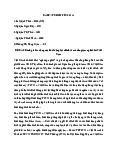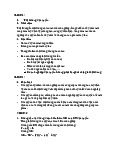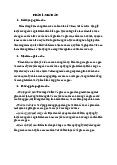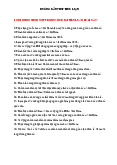

Preview text:
Chapter 1 I. True/Flase 1.
Macroeconomics studies long-run economic growth and short-run economic fluctuation TRUE 2.
Real GDP totals the dollar value of all goods and service within the borders of a given
country using their current prices during the year they were produced FALSE – value of final goods and services 3.
An example of a macroeconomic policy question would be “Can governments promote long-run economic growth? TRUE 4.
Modern economic growth means that output rises at about the same rate as the population TRUE 5.
An example of economic investment, as economist use the term, would be the purchase
of a corporate stock or bond. FALSE 6.
Economies are exposed to both demand shock and supply shocks. TRUE 7.
A positive demand shock refers to a situation where demand turns out to be lower than expected. FALSE – higher II. Multiple choice 1.
Short-run fluctuations in output and employment are often referred to as A. Recession B. Inflation C. The business cycle D. Modern economic growth 2.
Economic growth in an economy is best measured from one year to the next by comparing the change in A. The rate of inflation B. The rate of unemployment C. Nominal GDP D. Real GDP 3.
Unemployment is undesirable because it A. Increases inflation B.
Wastes labor resources. Lãng phí nguồn nhân lực C. Contributes to sticky prices D.
Raises interest rates in the economy 4.
A major problem with inflation is that it A. Lowers housing prices B. Increase the rate of savings C.
Reduces purchasing power. Giảm sức mua D. Decrease government spending 5.
What account for the vast difference in the living standards today between and rich poor countries ? A. Purchasing power parity B. rising rates of inflation C. Increase in nominal GDP D. Modern economic growth 6.
Macroeconomic behavior is most significantly influenced by A. Purchasing power parity B.
Expectations about the future C. The price of agricultural land D.
Employment in the construction industry 7.
Economic forecasters had expected consumer spending to increase by 5 percent this year,
but instead it increases by 0.5 percent. This situation would be an example of a A. Positive supply shock B. Negative supply shock C. Positive demand shock D.
Negative demand shock. Cú sốc nhu cầu tiêu cực – nhu cầu giảm III. Problems 1.
Assume that in Year 1 an economy produces 100 units of output that sell for 50$ a unit,
on average. In year 2, the economy produces the same 100 units of output, but sells them for $55 a unit, on average. a.
What is nominal GDP in Year 1? 100 units x $50 = $5.000
What is nominal GDP in year 2? 100 units x $55 = $5.500. Nominal GDP increased from Year 1
to Year 2 because (prices, output) price increased. b.
Use Year 1 prices to calculate real GDP in year 1 and year 2. What is real GDP in Year 1? 100 units x $50 = $5.000
What is real GDP in Year 2? 100 units x $50 = $5.000. Real GDP did not increase from Year 1 to
Year 2 because (price, ouput) output did not change.




